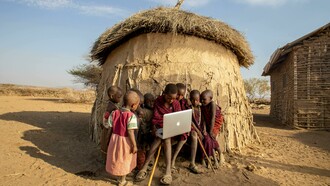Someone said, "A civilization is measured by how it treats its weakest members." By that yardstick, our 21st-century civilization falls far short. The wealthiest one percent of the global population owns nearly half the world’s wealth. Those with little wealth suffer the consequences of civilization's shortcomings.
However, another type of wealth gap is even more important. It's the gap between the quality of life that's possible today and the lives our children will experience. The very young are among civilization's "weakest members" because they have little power to shape their futures.
The assumption has always been that each generation will make the world better for the next. That is not the case today. Older generations have brought the world to the brink of calamities on several fronts, including some that will permanently endanger and diminish the lives of all future generations.
However, what if we adults decided to dedicate the rest of this century to reshaping the future? What if we got serious about fixing humanity's dysfunctional relationship with the natural world?
For example, global climate change is one rapidly evolving crisis. A study in the journal Nature points out that more than 92 percent of today’s five-year-olds will experience unprecedented weather extremes, including deadly heat, if nations don't act aggressively and soon to reduce carbon pollution.
If anthropogenic climate change didn't exist, the chances of today's children suffering from extreme weather would be one in 10,000. Our children will never enjoy those odds. Even in the best-case scenario, some adverse impacts are already irreversible.
Even if the world rallied to hold global warming to no more than 1.5 degrees Celsius above preindustrial levels – the optimal goal of the Paris Climate Agreement – 58 million of the 120 million children born in 2020 would face lives of unprecedented weather disasters. As usual, the poorest children and adults would suffer the most.
It's not that the world lacks good intentions. The United Nations' 17 sustainable development goals aspire to alleviate poverty, illiteracy, poor health, inequality, and environmental ruin by 2030. However, the UN reported last year that none of the goals are on track to meet the deadline. The world has shown some progress on only 16 percent of the targets, while others are stagnant or slipping.
Countries agreed in 2015 to make 2 degrees Celsius above preindustrial temperatures the upper limit on global warming. Under current international commitments, 2.7 degrees is likely. It took 23 years for countries to agree to the Paris pact. It has been 10 years since nations signed it. However, with thousands of fossil-fuel lobbyists asserting their influence at annual climate conferences, nations did not even mention fossil fuels in their negotiations until last year. They still haven't agreed on a timetable to phase out those fuels.
Two hundred years of industrialization have produced the most significant environmental problems. Countries have been creating environmental agreements since the 1800s. Today, 3,500 bilateral and multilateral agreements cover a variety of ecological issues. This year alone, nations are meeting to negotiate about sustaining ecosystem services, controlling plastics pollution, confronting global warming, preserving biodiversity, reducing air pollution, saving oceans, limiting chemicals, conserving wetlands, preventing desertification, protecting water resources, preserving glaciers, and healing the Earth's ozone layer.
Scientists have identified nine critical planetary boundaries humanity cannot exceed without threatening the planet's health. We have already exceeded six.
What might some of the elements be in a 75-year campaign to "Save the Planet, Save Ourselves?"
First, all nations should agree to decouple economic progress and quality of life from environmental degradation. We should reshape our policies and institutions to achieve prosperity through productive harmony with nature. It would be profitable. The planet's ecosystems provide societies with up to $145 trillion1 in annual benefits, according to one study. A $25 billion global industry2 that generates 220,000 jobs exists for restoring damaged ecosystems in the U.S.
Collaboration would also be safer. Healthy ecosystems, such as wetlands, natural floodplains, and urban and rural forests, reduce weather-related damages.
Decoupling is a key component of the European Union’s “green deal.” One approach is to create circular economies that reuse, recycle, and regenerate resources.
Second, we should build bridges between existing and emerging agreements on environmental, social, and economic issues. While we deal with them separately, they are connected and should be considered holistically as systems. This will help ensure we engage in problem-solving rather than problem-switching, where solutions cause new problems.
Third, we should liberate markets by eliminating regressive government subsidies and making the price of goods and services accurately reflect their actual and quantifiable costs and benefits. Market forces will not work well for the betterment of people and the planet until we stop "externalizing" costs.
For example, if the price of fossil fuels accurately reflected their costs to ecosystem services, environmental quality, and public health, markets would have forced their retirement in favor of clean energy many years ago.
Fourth, we must improve environmental education at every level, starting at pre-school. Ecological studies and exposure to nature should emphasize humanity's interconnection and interdependence with all life.
Fifth, every nation should codify the rights of nature. Laws and constitutions should recognize that nature has an enforceable legal right to "exist, flourish, regenerate its vital cycles, and evolve without human disruption."
This requires a shift from regarding the natural world as something to exploit and control to understanding that we are part of it, along with other lives infused with the intelligence of 3.5 billion years of trial and error.
While giving nature the rights of "personhood" may sound radical, a worldwide movement is already underway. As of 2022, 24 countries, several Tribal Nations, and over 60 localities in the U.S. had adopted rights of nature laws.
Sixth, nations should also establish the legal rights of future generations. The UN, among many others, advocates "the right of children, youth, and future generations to a healthy environment.
Seventh, the world's wealth should focus on preparing the world for our children. Foundations, philanthropies, governments, and wealthy individuals should collaborate to support the 75-year campaign. Researchers say the wealthiest 10 percent of the world's population has caused two-thirds of the planet's warming. In the United States, the world's largest economy, the richest 10 percent contribute 17 times more to global warming than the global per capita average.
The rich have had a significant role in climate change and must have a substantial role in addressing it.
Finally, children must have the opportunity to help determine the future they want and the strategies to achieve it. The UN, among others, advocates "meaningful participation (by young people) in decision-making at all levels, in relation to climate action and climate justice."
So far, children have relied on moral persuasion in a world dominated by profit, tribalism, and short-termism. In 1992, at the First Earth Summit, for example, 12-year-old Severn Suzuki appealed to world leaders in a viral speech that became known as 'Six Minutes that Silenced the Earth."
"Do not forget why you are attending these conferences — who you're doing this for," she told the assembled delegates. "We are your own children. You are deciding what kind of world we are growing up in...Are we even on your list of priorities?
She continued, "You don't know how to bring the salmon back up in a dead stream. You don't know how to bring back an animal now extinct. And you can't bring back the forests that once grew where there is now a desert. If you don't know how to fix it, please stop breaking it.
“Here, you may be delegates of your governments, business people, organizers, reporters, or politicians. But, really, you are mothers and fathers, sisters and brothers, aunts and uncles — and all of you are someone's child. "
Twenty years later, Severn spoke at a second Earth Summit attended by 50,000 people. Now, she was a mother of two. She reported that the video of her first speech still circulated widely online.
"I think that this phenomenon shows that the world is hungry for this message," she explained. "We are desperate to hear someone speak the truth, speak this message. We need someone to cut through all the rationalizations we have built up for the destruction of our planet. And no one can do this better than those with everything at stake, which is our youth."
The public impact of her speech in 1992, she said, was due to the "power of intergenerational love."
More recently, with more persuasion proving ineffective, some young leaders have tried shaming. In 2019, another young environmental leader, 16-year-old Greta Thunberg, addressed delegates at a UN Climate Action Summit. She noted angrily that the world still had not risen to the challenge of climate change.
"You have stolen my childhood and my dreams with your empty words, and yet I'm one of the lucky ones," she said. "People are suffering, people are dying. Entire ecosystems are collapsing. We are at the beginning of a mass extinction, and all you can talk about is money and fairytales of eternal economic growth. How dare you?
"You are failing us, but young people are starting to understand your betrayal. The eyes of all future generations are upon you. And if you choose to fail us, I say we will never forgive you."
We adults can't let our crimes against the future get that far. There is still time for redemption, but it will require an energized, proactive, sustained, and profoundly committed intergenerational movement until all the promises of environmental agreements are finally kept.
In the process, the economic interests that fight so hard to sustain our unsustainable status quo will discover that they also benefit from creating the future our children deserve.
References
1 Mapping global value of terrestrial ecosystem services by countries by ScienceDirect.
2 Ecological restoration is a $25 billion industry that generates 220,000 jobs by Ecosystem Marketplace.















